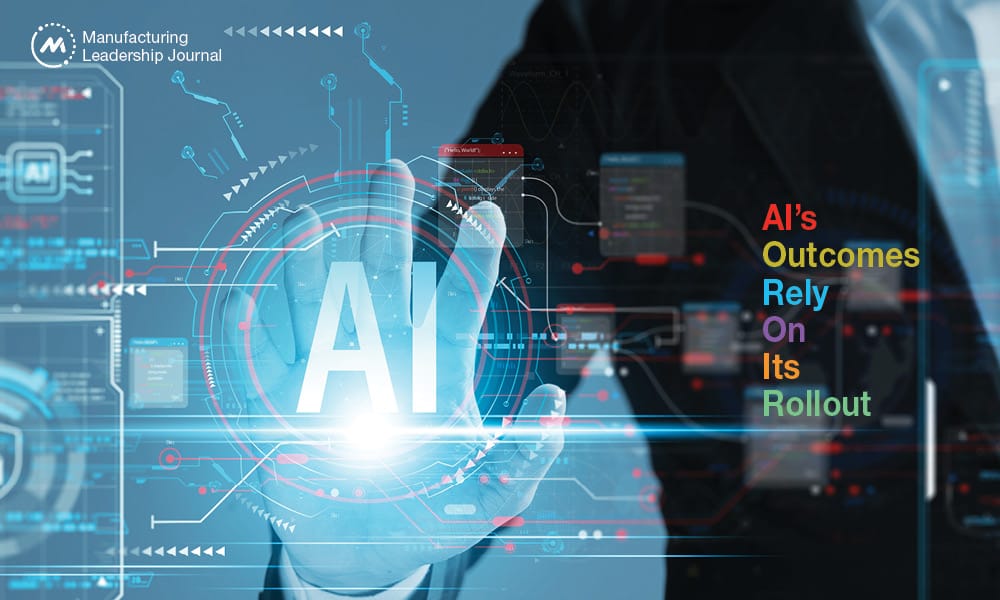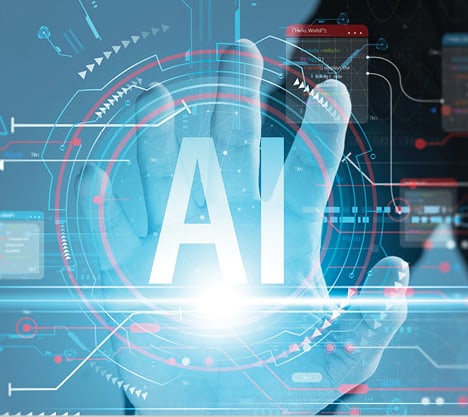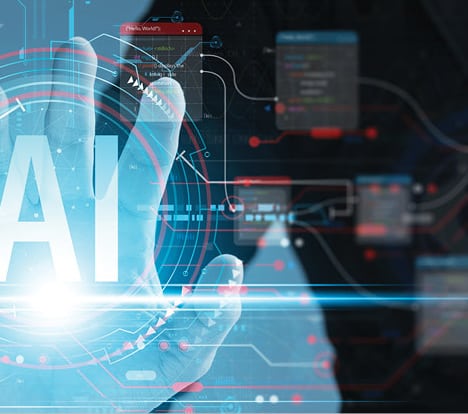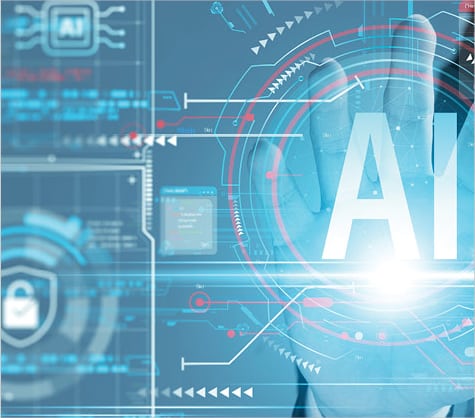AI’s Outcomes Rely On Its Rollout

If done right, AI will revolutionize everything from safety and quality to efficiency and maintenance

TAKEAWAYS:
● AI represents a unique opportunity to improve the efficiency of production, especially when it comes to preventative maintenance.
● Integrating AI into production can increase cyber risk by creating new potential access points for bad actors.
● More extensive training is required for AI to accomplish complex tasks, while repetitive tasks require less training.
For centuries, manufacturers have faced the challenge of addressing safety hazards in factories while boosting efficiency and controlling costs. Now, many manufacturers are learning that artificial intelligence (AI) can help them make new strides when addressing protracted worker safety and efficiency challenges. Consequently, it is no surprise that 36% of manufacturers say they will pursue Industry 4.0 investments according to the 2023 BDO Manufacturing CFO Outlook Survey. As more manufacturers explore AI’s future and how it can help them improve safety and efficiency, it is critical that they set themselves up for success by securing employee buy-in and preparing factory infrastructure to take full advantage of AI-based systems.
Today, much of the public has become aware of generative AI, such as OpenAI’s ChatGPT, with its ability to quickly answer complex problems with written prompts. Generative AI is exciting to the general public, but many plant managers are passionate about AI systems that are specifically designed to operate in a manufacturing setting. Rather than only using written prompts, AI systems used by manufacturers leverage inputs from computer vision, lasers, and other sensors to predict when a safety issue may occur, which robot caused a manufacturing defect, and how machines should be calibrated to minimize downtime.
Leveraging Technology to Combat Safety Hazards
Despite decades of regulations and improved protocols, safety issues persist in modern manufacturing. Updated safety codes and maintenance plans cannot always prevent worker injuries that result from negligence or unpredictable hazards in a manufacturing facility. While strong employee training programs remain one of the best ways manufacturers can improve safety in settings from chemical plants to automobile factories, even the most dedicated employees are not constantly vigilant to workplace dangers. This is why many manufacturers are investing in AI-powered safety systems, which can predict when and where a safety violation could happen, allowing plant managers, and sometimes the AI itself, to remedy the situation before it becomes irreparable.
However, to work successfully with AI, workers need to be trained to interact with these new systems. The latest advancements in augmented reality (AR) and virtual reality (VR) technologies enable companies to make training programs for employees who interact with AI-powered safety systems even more effective, further empowering workers to keep themselves safe. AR or VR simulations can give employees a sense of what it is like to work with potentially dangerous machinery in preparation for operating the real equipment. Workers can also practice carrying out the necessary safety procedures before entering a secure area or shutting down a robot in need of repairs on the factory line. These AR- or VR-enabled training exercises can reduce the likelihood of mistakes, which could result in worker injury or damage to machinery.

“Many manufacturers are investing in AI-powered safety systems, which can predict when and where a safety violation could happen”
While AR and VR training can help workers keep themselves safe, these simulations can also teach factory employees about AI systems designed to improve safety. Many workers have never interacted with AI systems tasked with actively reinforcing safety guidelines before and may be inclined to ignore or distrust safety alerts that do not come from a person. AR and VR training can incorporate scenarios where a machine breaks down, or a co-worker fails to follow safety protocols to teach employees about which hazards an AI safety system can detect and how they should respond.
Detect Issues with Computer Vision
One of the main methods AI safety systems detect potential hazards is through computer vision. This technology lets AI “see” the factory floor through cameras, allowing the AI to raise safety alerts in real-time if, for example, it observes employees who might not be wearing the proper personal protective equipment (PPE). In geofenced safety zones, a computer vision-enabled AI can shut down equipment, restrict access to certain areas, and alert employees if it sees or anticipates a safety concern. It is important to note that AI-based safety systems are not a replacement for traditional training. Rather, AI-enabled computer vision is an important tool that factory managers can use to make their plants even safer.
AI can also help manufacturers improve safety on an individual employee level with the help of data analytics. An AI system can keep tabs on the number of safety incidents an employee is involved with, like warnings or violations. Then, AI can take this data and factor it in with individual employee information to construct a holistic view on a worker’s safety record. This record can be informed by data like years of experience, hours worked, and metrics collected from a wearable device like body temperature, muscle strain, and the amount of weight lifted per shift by the employee. Manufacturers can use this to better understand if their employees are under too much strain to sustain a safe working environment. Not only can manufacturers use AI-powered data analytics to determine which employees would benefit from additional safety training, plant managers can also use this information to better match employees to tasks based on their skills and physical abilities.
For decades, manufacturers have tapped robots to take over tasks that have a high risk of causing worker injury. Keeping humans away from heavy, moving machinery, toxic chemicals, and other risky environments has allowed manufacturers to place people in safer roles where specific skills and dexterity are highly valued. For example, even the most capable human workers possess a limited field of view. A forklift crash in a warehouse caused by a worker who failed to pay attention or missed a small hazard in their way could be devastating. However, an AI-powered forklift can use computer vision to monitor for hazards across the warehouse, reducing the risk it could bump into an employee or be crushed by a stack of pallets it crashed into. The former forklift operator could be reskilled into an oversight or maintenance role where they could provide even greater value.
Manufacturers can also assign dangerous inspection tasks to AI. Drones equipped with AI can inspect products stacked up to the high ceiling of a warehouse and determine the stability of the inventory. In plants where noxious fumes or dangerous chemicals are present, AI-powered robots can limit human exposure to potential hazards by performing regular maintenance and monitoring tasks. When humans must be involved in chemical plant turnarounds and total cleanouts, AI can monitor for safety compliance and environmental hazards.
Embracing the New Efficiency Paradigm
AI also represents a unique opportunity to improve the efficiency of production, especially when it comes to preventative maintenance. Currently, most factories use pre-scheduled maintenance plans to help prevent manufacturing errors that could stymie production. While maintenance schedules have undoubtedly prevented production disasters, pre-scheduled maintenance plans can be inefficient because they are not always informed by actual repair needs.

“Publicly available generative AI systems can hallucinate, including making up facts, citing nonexistent sources, or other false information”
On the other hand, a predictive maintenance plan powered by AI can allow plant managers to perform maintenance exactly when and where it is needed. By gathering information from transducers and other sensors, AI can monitor equipment temperatures, current power draw, and the status of different machine parts. This can help an AI system predict and prevent failures. When the technology detects an impending problem, a predictive maintenance system can further limit downtime by scheduling repairs when they will be least disruptive to factory operations.
AI can also support quality assurance (QA) and quality control (QC) by using laser distance sensors to perpetually scan for errors across a vast and fast-moving production line. In addition to keeping tabs on the quality of manufactured goods, AI can help plant managers keep machines properly calibrated by monitoring tolerances. Because many QA and QC tasks are highly repetitive, an AI system that has been taught which defects to look for can perform these tasks, allowing employees to focus on higher-value tasks within the plant.
In addition to preventing production problems, AI can also be used to address manufacturing defects and prevent similar ones going forward. In the event a customer returns a product, a plant manager can use a serial number to quickly determine when the production error occurred, and even which machine caused the error. Traditionally, diagnosing and solving the issue which caused the production error can be time consuming. However, an AI system with laser distance sensors can scan the product to determine the exact nature of the error and then ascertain which machine caused the error and how the equipment can be recalibrated to both fix and prevent the issue. This allows a factory to reduce both downtime related to diagnostics and inventory lost to production errors.
AI’s Risks
AI is not without risks. Integrating AI into production can increase cyber risk by creating new potential access points for bad actors. Manufacturers pursuing AI must consider the risks related to cybersecurity and take measures to mitigate potential issues. Additionally, publicly available generative AI systems can hallucinate, including making up facts, citing nonexistent sources, or other false information. Businesses that do not put safeguards in place to check these outputs could make decisions based on inaccurate information. Finally, if a company enters proprietary data into a publicly available generative AI, it does not have control over how that data is stored or used by the AI. This means it could be hacked or used to inform answers the AI provides to other users.
Approach to Adoption
While the future of AI in manufacturing could involve a revolution in production efficiency, it is important to understand where this technology might not be a fruitful investment. The less repetitive and homogeneous the task, the more extensively an AI needs to be trained by humans to properly execute it. Jobs which require greater dexterity, creativity, and experience may simply be better for a human to perform from both a cost and quality standpoint. For example, a local furniture factory may find that a worker assigned to evaluate fit and finish may only be able to flag 90% of errors. Even if an AI equipped with computer vision and laser distance sensors could flag 99% of defects, the cost and complexity of training an AI to correctly spot miniscule flaws may make a digital QA/QC improvement strategy untenable.

“The cost and complexity of training an AI to correctly spot miniscule flaws may make a digital QA/QC improvement strategy untenable”
When it has been determined that AI-based systems are feasible tools, manufacturers should carefully evaluate the potential ROI by clearly outlining which capabilities their plant actually needs. For example, a plant that produces dangerous chemicals may need the infrastructure to support a robust network of air quality sensors across an entire plant. On the other hand, a large candle factory might only need to support air quality sensors in specific rooms, and thus has smaller infrastructure requirements. Finally, given worker concerns over the efficacy of AI-powered safety systems, plant managers must also help employees overcome their skepticism with a transparent dialogue.
Preparing to Adopt AI Systems in Manufacturing Facilities
Tools like computer vision, sensors, and drones require adequate networking capabilities to be effectively used by an AI system in a manufacturing setting. While networking is an additional expense, the barrier to entry for powering AI-powered systems is lower than many manufacturers may think. In most cases, 5G wireless networking is not cost-prohibitive and is more than sufficient to provide fast, reliable connectivity.
A third-party vendor can be tapped to install the 5G networking equipment and software, as well as provide regular maintenance, software updates, and technical support. AI systems which rely on 5G-connected inputs can also be provided by third-party vendors, who may charge a monthly subscription to use their software or hardware. For most manufacturers, using a third-party vendor to supply and manage AI systems and networking equipment can help save money while allowing them to stay up to date with the latest technologies.
Enabling Employee Adoption
While the infrastructure for AI-based systems can be paid for with a monthly subscription, securing buy-in from factory workers being instructed to adopt AI systems is more complicated. Manufacturers can employ a variety of strategies to help employees understand that AI can make their jobs safer — not render them obsolete.
To overcome skepticism, manufacturers should start by demonstrating success via small pilot projects that illustrate the value of AI systems to workers. Tapping an influential employee to serve as an AI ambassador can help make pilot success stories more personal and authentic during discussions with skeptical employees and stakeholders. Demonstrating that workers’ safety is a priority and providing a platform for their concerns to be heard can also build faith that AI systems are there to support them in the workplace.
Depictions in popular culture often characterize AI as a risky unknown, or as a tool that executives use to automate away manufacturing jobs. Manufacturers should reiterate to workers that their industry faces a labor shortage, and rather than replacing jobs, AI can help factories fill some of the roles for which companies are struggling to hire. AI can also open doors for current employees to move into more productive, less repetitive roles. This could allow many workers to deploy their skills in a more valuable way while also working in a safer environment.
The Future of AI in Manufacturing
AI has the potential to transform worker safety and boost efficiency — but not in a vacuum. Manufacturers should take care to determine that investments in AI, including employee training, infrastructure development, and buy-in campaigns, will likely lead to tangible improvements to worker safety and generate cost savings from efficiency gains. For example, manufacturers won’t realize the benefits of sensors and cameras tasked with helping an AI system prevent manufacturing defects if the networking equipment that connects them to an AI system is unreliable or inadequate.

“Tapping an influential employee to serve as an AI ambassador can help make pilot success stories more personal and authentic”
Even with the most meticulously planned AI systems, manufacturers who are serious about AI success must train and educate workers to make them feel more confident in AI. Highlighting AI success stories, especially those that emphasize collaborative roles with employees, can help earn the support of factory or warehouse staff. Without employee buy-in, manufacturers may struggle to improve worker safety or boost efficiency with the power of AI.
Over the coming decades, new technologies are likely to help manufacturers achieve ever greater improvements to worker safety and factory. As companies grapple with the implementation of today’s AI technology, plant managers should remember that even the most exciting technologies can change little on their own. Manufacturers who learn to quickly secure employee buy-in and source a strong infrastructure of supportive technology will find themselves leading innovation rather than following other innovators. M
About the author:

Maurice Liddell is Principal and Senior Market Leader at BDO Digital